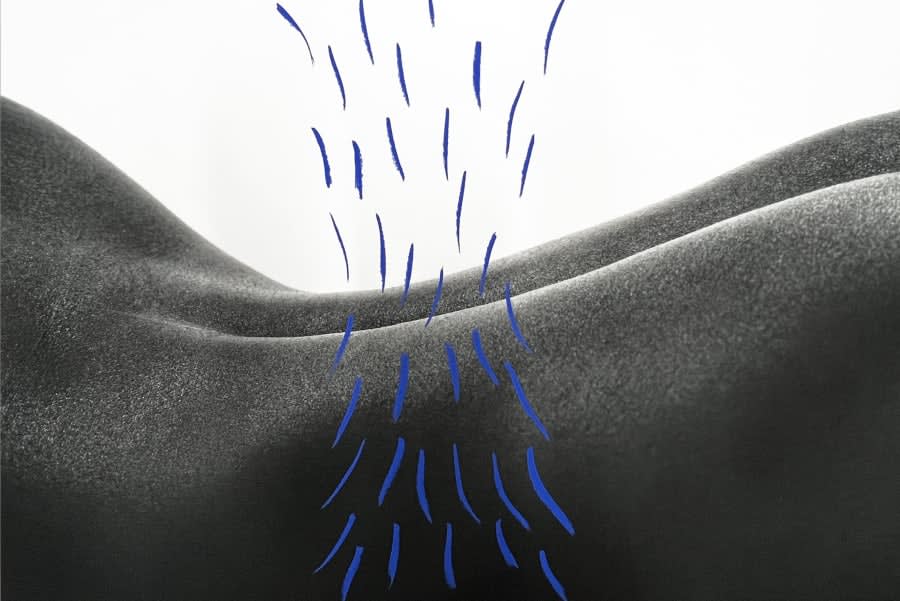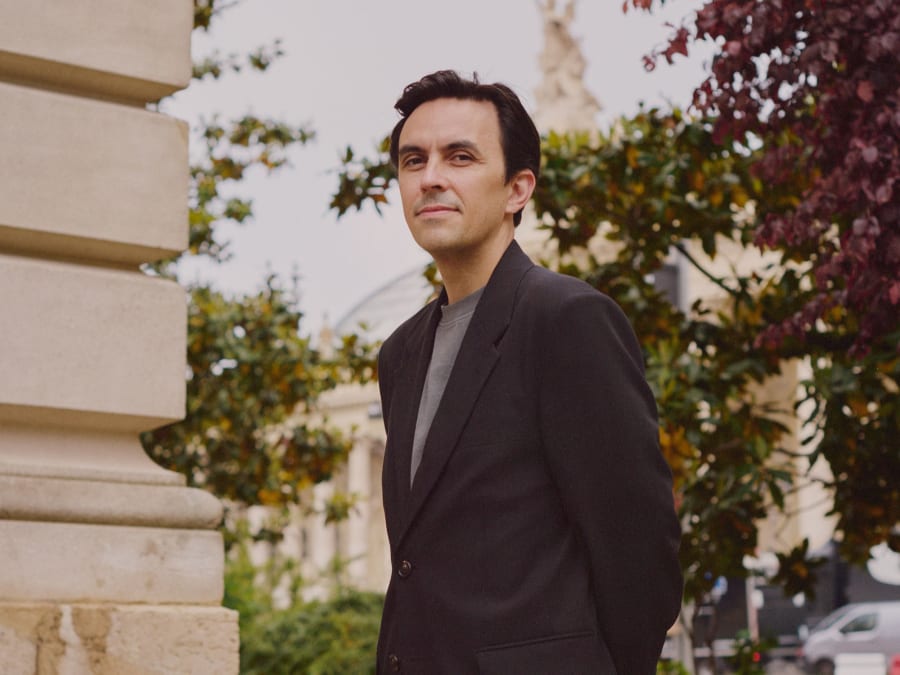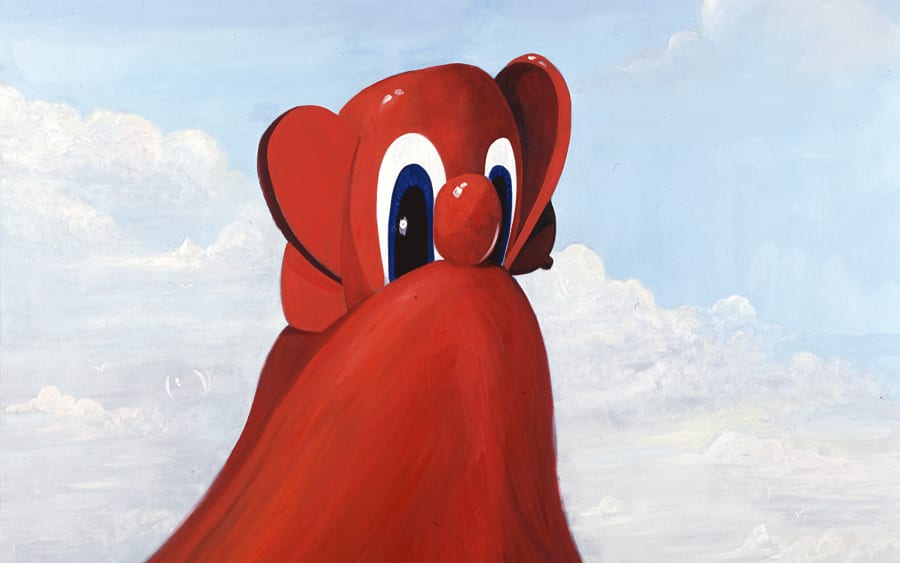Amedeo Modigliani
Jeune fille aux macarons [Young Woman with Hair in Side Buns], 1918
Presented by Pace Gallery (New York, Berlin, Geneva, Hong Kong, London, Los Angeles, Seoul, Tokyo)
Facing the triple threat of empty pockets, tuberculosis, and the lingering effects of too many wine-soaked nights in Paris, the Italian painter Amedeo Modigliani moved to the south of France in 1918, hoping the mild climate and sea air might restore his health. Accompanied by his partner and their newborn daughter, Modigliani found himself far from his circle of bon-vivant Parisian friends. So he painted local shopgirls, servants, and children, producing a body of portraits marked by quiet poise. The rare painting Young Woman with Hair in Side Buns (1918) bears Modigliani’s calling cards: an elongated neck, almond eyes, and a calm, meditative face.
Senga Nengudi
Reverie – Stale Mate, 2014
Presented by Sprüth Magers (Berlin, London, Los Angeles, New York)
In the late 1970s, in response to the physical transformations of pregnancy, American artist Senga Nengudi began a new series of sculptures. She found the perfect medium in pantyhose: they were pliable, elastic, and sometimes droopy – in short, a lot like skin. Works in what has become a seminal series – known as ‘R.S.V.P.’ – see pantyhose stuffed, knotted, twisted, and stretched taut between walls to suggest bodies in states of strain and recovery. The series’ title, short for ‘please respond,’ alludes to performances in which dancers interact with the work. In Reverie – Stale Mate (2014), a stuffed nylon pelvis hangs against the wall, its empty legs drooping toward the floor.
Gino Severini
Danzatrice [Dancer], 1915–1916
Presented by Landau Fine Art (Montreal, Lucerne)
In 1910, Italian-born painter Gino Severini signed two Futurist manifestos in Paris, declaring his commitment to the art movement that celebrated speed, light, and mechanical markers of modernity. But while his peers were painting racing cars and factory scenes, Severini was keener on studying the human figure – particularly when it was dancing. In the spectacular canvas Danzatrice (1915–16), a dancer is segmented into bright, radiant planes. The dynamic painting was made during a pivotal period when Severini’s interests were beginning to shift toward a more structured, Cubist-inspired style – a transition he described as moving ‘from chaos to order.’
Ewa Juszkiewicz
Gloriosa, 2025
Presented by Almine Rech (Paris, Brussels, New York, Shanghai)
If portraiture’s raison d’être is simply to depict a face, Ewa Juszkiewicz gladly looks the other way. Known for her mischievous riffs on 18th- and 19th-century portraits, the Polish artist conceals her female sitters’ features with draped fabric, shells, cascading hair, or dense arrangements of plant life. Her style echoes the language of the Old Masters while exposing the stuffy conventions that defined images of women in art. In Gloriosa (2025), an elaborate bouquet swallows the figure’s head and hides her identity from view.
Gerhard Richter
Wolken (blau) [Clouds (blue)],
2025
Presented by David Zwirner (New York, Hong Kong, London, Los Angeles, Paris)
You could say that Gerhard Richter has had his head in the clouds for over 50 years. In the early 1970s, searching for source material for a new series of paintings, the German artist turned to his ‘Atlas’ archive – a sprawling collection of photographs, clippings, and sketches – and selected images of shifting skies. The resulting photo-paintings depicted the sky in large oil triptychs rendered with soft light and faithful precision. Wolken (blau) (2025) revisits one of the cloud works as a three-panel, editioned chromogenic print, continuing Richter’s interest in multiples.
Félix González-Torres
“Untitled” (March 5th) #1, 1991
Presented by Xavier Hufkens (Brussels)
Two lightbulbs, two billboards, two synchronized clocks: pairs appear often throughout Félix González-Torres’s spare and poetic artworks. For the late artist (1957–1996), whose practice often addressed love and loss, these twinned forms suggest balance and connection, with each half completing the other. In “Untitled” (March 5th) #1 (1991), two circular mirrors hang side by side. While González-Torres never publicly explained his use of dates in titles – preferring to leave their meanings open to interpretation – March 5 marks the birthday of his partner, Ross Laycock, who died of AIDS the same year the work was made.
Agnes Martin
Children Playing, 1999
Presented by Pace Gallery (New York, Berlin, Geneva, Hong Kong, London, Los Angeles, Seoul, Tokyo)
In the late 1990s, then-octogenarian Agnes Martin began a new body of work that reflected a softening of her earlier restraint. Painting in her New Mexico studio, Martin began loosening her lines and gently brightening her palette to explore themes like childhood, imagination, and joy. Each canvas from this series, known as ‘Innocent Love’, shares the same 152 x 152 cm format and a quiet rhythm of parallel bands in pale hues that seem to emit rather than reflect light.Children Playing belongs to this phase, its soft pink-and-yellow lines capturing the calm that defined those later years.
Jean Dubuffet
Cité Fantoche, 1963
Presented by Landau Fine Art (Montreal, Lucerne)
Those drawings you make while on the phone might be worth a second look. It was one such doodle that sparked a new visual language for Jean Dubuffet in 1962. Inspired by the expressive quality of his absentminded lines, the French artist abandoned the dense, textured city scenes he had been painting for a new, more restrained style. Defined by meandering black lines enclosing patches of electric color, Dubuffet called this languageL’Hourloupe – a made-up word meant to suggest a ‘wonderland or grotesque object or creature.’ Teeming with energy and mingling figures, Cité Fantoche (1963) is one of L’Hourloupe’s earliest and most accomplished expressions.
Zeng Fanzhi
Lóng Táitóu V, 2024
Presented by Hauser & Wirth (Zurich, Basel, Hong Kong, London, Los Angeles, New York, Paris, Somerset, St. Moritz)
Zeng Fanzhi’s paintings have changed dramatically since the early ‘Mask’ series he became famous for in the 1990s, in which suited figures wore smiling masks to hide their unease. By the 2000s, the Wuhan-born artist dropped the masks to reveal the faces beneath them, and soon after, dropped figuration altogether. Drawing on the gestural freedom of Chinese ink painting, he began making large-scale, expressive paintings in which twisting lines, swooping strokes, and frenetic color suggest abstract landscapes. In Lóng Táitóu V (2024), textured paint creates the impression of snow-covered branches. The work’s title refers to a spring festival that celebrates the dragon’s ‘raising of its head,’ marking the season’s first stirrings of renewal.
Alexander Calder
Caged Stone on Yellow Stalk, 1953
Presented by Gladstone Gallery (New York, Brussels, Seoul)
Alexander Calder – the patron saint of the mobile – was known to compare the motion of his sculptures to dance. So it was fitting that, in the mid-1930s, the American ballerina Ruth Page’s husband asked Calder to create a large-scale work to accompany his wife onstage. While that collaboration was never realized, Calder later created this work, Caged Stone on Yellow Stalk (1953), which Page later owned. With its curving stem and delicately balanced wire forms suggesting a head and limbs, the mobile reflects Calder’s enduring admiration for many forms of movement.
Elliat Albrecht is a writer and editor based in Canada. She holds a BFA in Critical and Cultural Practices from Emily Carr University of Art + Design and an MA in Literary and Cultural Studies from the University of Hong Kong.
Art Basel Paris will take place at the Grand Palais, from October 24 to 26, 2025. Discover the participants and detailed information here.
Caption for header image: Gino Severini, Danseuse, 1915-1916 (detail). Courtesy of Landau Fine Art.
Published on October 16, 2025.


